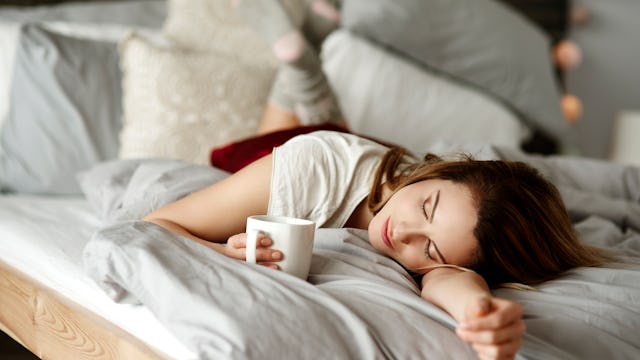Stop What You're Doing And Go Take A Coffee Nap

The two greatest things in the known universe—things that heretofore did not appear to make sense together—are actually, according to science, more effective when used in conjunction with one another.
REJOICE.
Though it may sound impossible, coffee and naps — our two favorite things — have been confirmed to work better together, and they are called, wait for it… Coffee naps. I know, not very original, but still, coffee naps are an actual thing that now exists in our universe, hallelujah, Christmas has come early.
Who the heck drinks coffee and then attempts to fall asleep? Well, there’s a trick to it; you don’t just guzzle a pot of coffee, scroll Instagram for a half hour, and then go lie down and hope to fall asleep. Even if you could fall asleep after guzzling that much coffee, your urge to pee would definitely wake you up.
Here’s how to master the coffee nap and wake up ready to tackle the rest of your day:
First, you need to understand how caffeine affects the brain, and in particular how it interacts with a chemical our brains produce called adenosine. Adenosine is a normal byproduct of brain function (i.e. being awake and thinking about stuff), but when enough of it accumulates in the brain, it links up with the brain’s adenosine receptors and produces a feeling of sleepiness. Basically, it’s your brain’s way of saying “You’re tired AF. Go get some sleep, fool.”
Well, caffeine is shaped much like adenosine, which means it can fit into the same receptors adenosine normally fits into, thereby blocking the adenosine and preventing that icky tired feeling. But, if you’ve ever had a cup of coffee and still felt tired afterward, you may have already guessed that caffeine can’t block all the adenosine. It competes with the adenosine, blocking some, but not all.
Enter the catnap. Sleep naturally rids the brain of adenosine. But when it comes to mastering the coffee nap, here’s where you have to be careful. If you take too long of a nap, you risk entering deep sleep, which is brutal to wake up from—you know that feeling when you accidentally sleep for a couple of hours during the day and wake up not knowing what year it is? Yeah. Not an ideal way to promote alertness.
So, the key to this magical gift from the gods is proper timing. Consume your caffeine quickly—as in, ingest it in under a few minutes—and get your ass to sleep before the caffeine can get to your brain and block your adenosine (and also before the urge to pee wakes you up). A shot of espresso would work perfectly for this.
The amount of time it takes the caffeine to hit your brain is—try and tell me this is not a gift from the gods—exactly the length of the ideal catnap: about 20 minutes.
So… 20 minutes of sleep to clear away some tiredness-inducing adenosine, and then, right about the time you wake up, the caffeine kicks in to block the rest. The world may be a fucking dumpster fire, but the gods have taken pity on us lowly mortals and given us this small but precious gift.
Scientists haven’t yet been able to observe this phenomenon as it happens in the brain. The coffee nap concept is based on our existing knowledge of caffeine, sleep, and how adenosine functions in the brain. But studies have been done to test the idea. One, at Loughborough University in the UK, tested tired subjects in a driving simulator. The subjects who took a 15-minute coffee nap performed better than the ones who only drank coffee or only took a nap. Even study participants who reported not falling completely asleep during the 15 minutes committed fewer errors in the simulator.
There are even some studies that have shown coffee naps can assist people with going longer stretches without a full night’s sleep. One study had 24 young men abstain from sleep for a 24-hour period, allowed only to take “coffee naps.” Twelve of the participants were given caffeine before their naps, while the other 12 were given a placebo. Cognition tests revealed that the men who took caffeine prior to their catnaps performed far better than their placebo-taking counterparts—almost at the level they would have performed on a full night of sleep.
It goes without saying that using this technique for prolonged periods could eventually be harmful. Do what you can to get the real sleep your body desperately requires, but, in a pinch, revel in the marvelous, glorious gift of the coffee nap.
Now, if you’ll excuse me, I need to set my phone’s timer for 20 minutes. I have an espresso and a couch with my name on them.
This article was originally published on